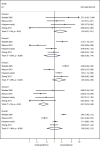Prediction of gastric cancer development by serum pepsinogen test and Helicobacter pylori seropositivity in Eastern Asians: a systematic review and meta-analysis
- PMID: 25314140
- PMCID: PMC4196955
- DOI: 10.1371/journal.pone.0109783
Prediction of gastric cancer development by serum pepsinogen test and Helicobacter pylori seropositivity in Eastern Asians: a systematic review and meta-analysis
Abstract
Background: To identify high-risk groups for gastric cancer in presumptively healthy populations, several studies have investigated the predictive ability of the pepsinogen test, H. Pylori antibodies, and a risk-prediction model based on these two tests. To investigate whether these tests accurately predict gastric cancer development, we conducted a systematic review and meta-analysis.
Methods: PubMed and other electronic databases were searched for cohort studies published in English or Japanese from January 1985 through December 2013. Six reviewers identified eligible studies, and at least two investigators extracted data on population and study-design characteristics, quality items, and outcomes of interest. Meta-analyses were performed on non-overlapping studies.
Results: Nine prospective cohorts from Eastern Asia reported in 12 publications, including 33,741 asymptomatic middle-aged participants of gastric cancer screening, were eligible. For discriminating between asymptomatic adults at high and low risk of gastric cancer, the pepsinogen test (summary hazard ratio [HR], 3.5; 95% confidence interval [CI], 2.7-4.7; I2 = 0%) and H. pylori antibodies (summary HR, 3.2; 95% CI, 2.0-5.2; I2 = 0%) were statistically significant predictors as standalone tests. Although the risk-prediction model was in general moderately accurate in separating asymptomatic adults into four risk groups (summary c-statistic, 0.71; 95% CI: 0.68-0.73; I2 = 7%), calibration seemed to be poor. The study validity was generally limited.
Conclusions: The serum pepsinogen test, H. pylori antibodies, and the four-risk-group model for predicting gastric cancer development seem to have the potential to stratify middle-aged presumptively healthy adults. Future research needs to focus on comparative studies to evaluate the impact of screening programs adopting these tests. Also, validation, preferably with model updating, is necessary to see whether the current model performance is transferable to different populations.
Conflict of interest statement
Figures





References
-
- Ferlay J, Soerjomataram I, Ervik M, Dikshit R, Eser S, et al.. (2013) GLOBOCAN 2012 v1.0, Cancer Incidence and Mortality Worldwide: IARC CancerBase No. 11. Lyon, France: International Agency for Research on Cancer. Available: http://globocan.iarc.fr/Default.aspx. Accessed 2013 Dec 29.
-
- Bray F, Ren JS, Masuyer E, Ferlay J (2013) Global estimates of cancer prevalence for 27 sites in the adult population in 2008. Int J Cancer 132: 1133–1145. - PubMed
-
- The Steering Committee for the Development of Gastric Cancer Screening Guidelines (2013) The Japanese Guidelines for Gastric Cancer Screening. Available: http://canscreen.ncc.go.jp/. Accessed 2013 Dec 29.
-
- Leung WK, Wu MS, Kakugawa Y, Kim JJ, Yeoh KG, et al. (2008) Screening for gastric cancer in Asia: current evidence and practice. Lancet Oncol 9: 279–287. - PubMed
-
- Foundation for Promotion of Cancer Research. Cancer Statistics in Japan - 2013. Available: http://ganjoho.jp/data/professional/statistics/backnumber/2013/cancer_st.... Accessed 2013 Dec 29.
Publication types
MeSH terms
Substances
LinkOut - more resources
Full Text Sources
Other Literature Sources
Medical

